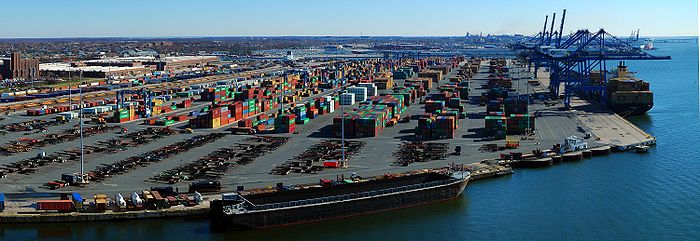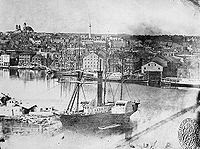Helen Delich Bentley Port of Baltimore, Baltimore, Maryland, consists of seaport facilities for cargo, especially roll-on/roll-off ships, and passengers operated by the Maryland Port Administration (MPA), a unit of the Maryland Department of Transportation,.
History of Helen Delich Bentley Port of Baltimore,
In 1608, Captain John Smith traveled 170 miles from Jamestown to the upper Chesapeake Bay, leading the first European expedition to the Patapsco River, named after the native Algonquians who fished shellfish and hunted.
English land grants 1661 were combined 1702 by James Carroll who named it Whetstone Point (now known as Locust Point). The port was founded on this site in 1706 by the Maryland Colonial Assembly as a Port of Entry for the tobacco trade with England. In 1729 the point was incorporated into Baltimore. Starting in 1776 local citizenry erected earthworks named Fort Whetstone for port defense during the Revolutionary War, which was replaced in 1798 by Fort McHenry.
Fells Point, first named Long Island Point in 1670, the deepest point in the natural harbor, soon became the colony's main ship building center, with many shipyards, famed for the construction of Baltimore clippers. These were notorious as raiders and privateers, which lead to the British attack in 1814 in the Battle of Baltimore, with the famous bombardment of Fort McHenry. Fells Point was incorporated into Baltimore in 1773. The Continental Navy ordered their first frigate, USS Virginia, from George Wells in Fells Point in 1775. The first ship named the USS Constellation (1797) were produced at Harris Creek Shipyard here, and the third USS Enterprise (1799) at Henry Spencer's shipyard. Over 800 ships were commissioned from Fells Point shipyards from 1784 to 1821. The California Gold Rush lead to many orders for fast vessels; many overland pioneers also relied upon can goods from Baltimore.
A steamship docked in Federal Hill in 1849 with the Basilica and the Washington monument in the distance.
After the founding of Baltimore the waterfront developed drydocks, warehouses, ship chandlers, as well as industry including mills were built behind the wharves. In what is now Canton, John O'Donnell's plantation was developed for worker housing and industry, including the Canton Iron Works owned by Peter Cooper and others. In 1828 the Baltimore and Ohio Railroad (B&O) began track laying eventually extending into Locust Point in 1845. The arrival of the Baltimore and Ohio and other railroads made the port a major transshipment point between inland points and the rest of the world. By the 1840s, the Baltimore Steam Packet Company (Old Bay Line) was providing overnight steamship service on the Chesapeake Bay. After the Civil War, coffee ships were designed here for trade with Brazil. Other industrial activities in Canton included Baltimore Copper Smelting Company and small oil refineries, later purchased by Standard Oil. At the end of the nineteenth century, European ship lines had terminals for emigrants from Britain, Ireland, Germany, and Poland, for example.
Baltimore Harbor channels and approaches,
Maintenance of harbor channels and navigation aids began early. Dredging in the harbor can be traced back as far as 1783, when the Ellicott brothers (of Ellicott Dredges) excavated the bottom at their wharf in the Inner Harbor. In 1790 the state government began systematic dredging using a "mud machine", which used a horse-drawn drag bucket, later upgraded with steam power. In 1825 Sen. Sam Smith of Maryland petitioned Congress for federal funding for this work.
At this time Congress was smarting from the incursions of the War of 1812 and had determined to expand naval defenses. In Baltimore it led to the misconceived construction of Fort Carroll, but federal dredging appropriations preceded that project, beginning in 1830. This first project was completed in 1838. In the 1850s a second dredging project was undertaken, this time under Capt. Henry Brewerton, who was also in charge of the Fort Carroll project. He excavated a straight channel from Sparrows Point out to the mouth of the Patapsco near Seven Foot Knoll Light, which was erected in 1855; this channel, known today as the Brewerton Channel, continues to be the central link in the path into the harbor,.
Aerial view of the port of Baltimore,
In 1865 Maj. William P. Craighill took over as Baltimore District Engineer of the Corps of Engineers. His initial survey of the Brewerton Channel disclosed severe shoaling at the mouth of the river, and he excavated a new channel starting from the older channel at a point just northwest of Seven Foot Knoll and running south to the mouth of the Magothy River, where it turned to the southsoutheast and continued to Sandy Point, just north of the present location of the Chesapeake Bay Bridge. In the 1870s a cut-off channel was dug to ameliorate the turn between the old and new channels; the Brewerton Channel was also extended to provide a connection to the Chesapeake and Delaware Canal. Enlarged and extended to access various facilities within the port, the Brewerton and Craighill Channels continue in use to the present, essentially unaltered in configuration.
Federal lighthouse construction in the bay began in the 1820s, and one early project was the erecting of range lights to guide ships into the Patapsco. These lights, the North Point Range Lights, were lit in 1822, marking a path roughly the same as that of the current Craighill Cutoff Channel. Subsequent channel construction was followed shortly by light projects. Brewerton's channel was marked by the Hawkins Point and Leading Point lights, constructed in 1868 and converted to skeleton towers in 1924. The original (lower) Craighill Channel was marked with range lights in 1875, following two years of temporary lightships; the cutoff was marked with the upper range lights in 1886, replacing the North Point range, which had been discontinued in 1873. In later years a pair of skeleton towers were erected on Locust Point to mark the Fort McHenry Channel, the final leg from the end of the Brewerton Channel to Curtis Point and the Inner Harbor. All of these lights remain in use, though of course all have been automated. The Craighill Channel Lower Range Rear Light enjoys the distinction of being the tallest lighthouse in Maryland.
Current operations
Currently the port has major roll-on roll-off (ro-ro) facilities, as well as bulk facilities, especially steel handling. Most Mercedes-Benz cars that are imported into the U.S are handled here as well.
During 2008, 33 million tons in foreign commerce (imports and exports), valued at $45.3 billion were handled by the port. This was a 7.3% increase in tonnage over 2007, when 30.8 million tons of foreign commerce, valued at $41.9 billion, flowed through the port. The Port of Baltimore ranked 14th of 30 USA ports, handling 2.2% of the 1.5 billion tons in foreign tonnage managed by USA ports during 2008.
Water taxis also operate in the Inner Harbor. Governor Ehrlich participated in naming the port after Helen Delich Bentley during the 300th anniversary of the port.

Seagirt Terminal of Baltimore,
See more
- List of tallest buildings in Baltimore
- Culture of Baltimore
- Berger Cookies
- Baltimore Police Department
- List of mayors of Baltimore, Maryland
- United States Senate election in Maryland, 2010
- Helen Delich Bentley Port of Baltimore
- Media in Baltimore
- Sports in Baltimore
- List of museums in Baltimore
- Baltimore
- History of Baltimore
- List of films shot in Baltimore
- List of people from Baltimore
- Baltimore marathon prize money
- Baltimore marathon bigger, faster in year 10
- Baltimore Marathon




No comments:
Post a Comment